Mobile GPU Faceoff: AMD Dynamic Switchable Graphics vs. NVIDIA Optimus Technology
by Jarred Walton on September 20, 2011 6:40 AM ESTMedium Detail Gaming Comparison
We’re going to focus on the main gaming target for this level of hardware: our Medium presets. The Low preset tends to look pretty lousy in several of the games (StarCraft II being the worst), while our High settings are too much for the GT 540M/HD 6630M in about half of the titles, even at 1366x768. Medium detail on the other hand should give us 30+ FPS in nearly all of the games we’re testing while still providing decent visuals. Here are the results.
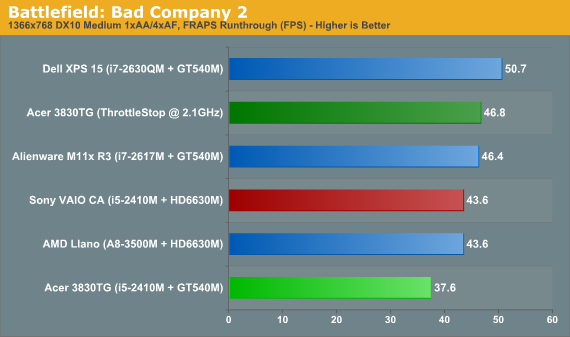

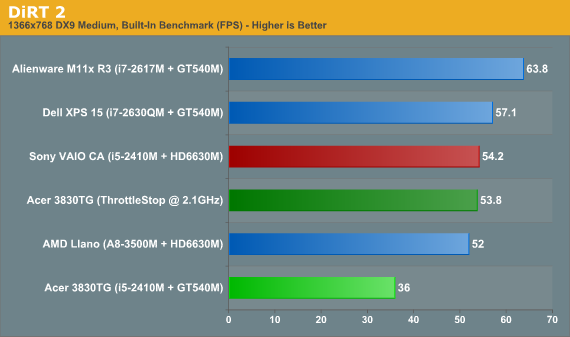
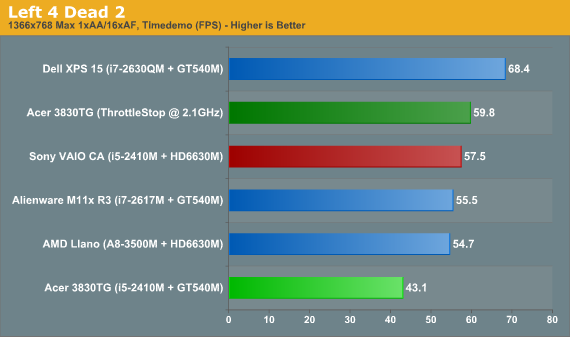
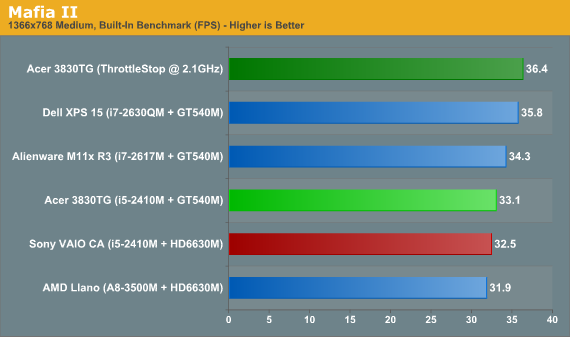


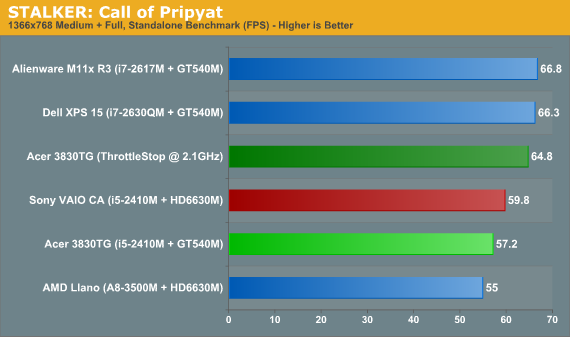
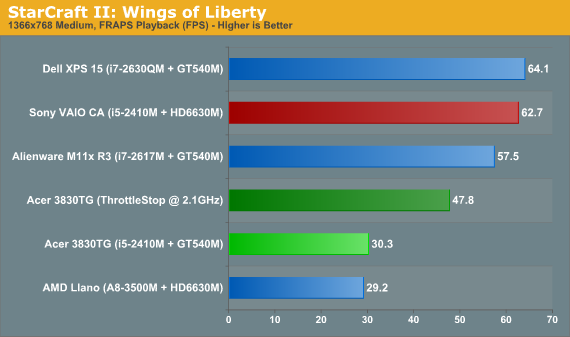
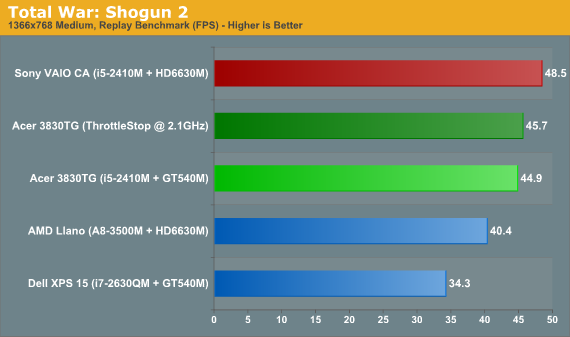
In terms of performance, the 6630M matches up nicely against the GT 540M. It wins a few games by a small margin, loses a few by a similarly small margin, and ties in the remainder. If we were just looking at gaming performance, there’s not much to discuss here. NVIDIA still has CUDA and PhysX, and AMD has their Accelerated Parallel Processing SDK, but given the level of performance we’re talking about, you won’t need or use these extras most of the time. Unfortunately for AMD, it’s not just about gaming performance.
We tested ten games (though we don’t have results from the Alienware M11x R3 in Civilization V and Total War: Shogun 2), and the newest titles are Civ5 (13 months old) and TWS2 (6 months old). You’d hope that with relatively known games, compatibility wouldn’t be an issue, but we ran into two problems during testing.
The first wasn’t a consistent problem, but we did have a couple of crash to desktop issues when benchmarking DiRT 2 using Dynamic Switchable Graphics mode. The other issue was a lot worse, and it was in StarCraft II when running at anything more than the Low default settings. As noted earlier, SC2 looks pretty lousy at its minimum settings, and Medium detail (and possibly even High) should be more than playable on the HD 6630M. In dynamic mode, however, not only was performance quite a bit lower than expected at our Low settings, but at Medium and above there were tons of missing textures. The solution is to switch to manually controlled switching, which solved both the performance and rendering errors, but then why even have dynamic switching in the first place?
While we’re on the subject, let’s also take a look at a few other comparisons. Running “stock” on the CPU, the Acer 3830TG is slightly slower overall than when using ThrottleStop to limit the CPU to 2.1GHz. With ThrottleStop, the average score across ten games improves by 20%, so the CPU throttling has a major impact in games. Civ5, ME2, and TWS2 show the least difference, with Mass Effect 2 being the only game that ran slightly faster at the stock CPU settings; Mafia 2 runs 10% faster, Metro 2033 and STALKRE are 13% faster, L4D2 jumps up 28%, DiRT2 is 49% faster, and the ever-CPU-limited StarCraft II runs 58% faster. Interesting to point out is that 2.1GHz is 75% higher than 1.2GHz, so on average it looks like the 3830TG runs around 1.3GHz in StarCraft II.
Flipping over to the other GT 540M equipped laptops and using the best result from the Acer 3830TG, the Alienware M11x R3 averages out to 3.5% faster, but it only has a clear lead in two games (DiRT2 and SC2) while it’s slightly slower in L4D2 and Mafia2. The Dell XPS 15 comes in 9% faster than the 3830TG on average, with the biggest lead again coming from SC2; Mafia2 once again gives the 3830TG a lead, so the latest NVIDIA drivers appear to be playing a role.
Finally, since we now have results from the HD 6630M with a Llano A8-3500M as well as the i5-2410M, we thought it would be interesting to see just how much performance you give up by gaming with the slower Llano CPU. If you’ll recall, in our first look at a Llano notebook, we expressed concern that the CPU would hold back GPU performance. Out of our ten tested titles, only Mass Effect 2 ran faster on Llano with a dGPU. Most games (at Medium settings where the GPU becomes more of a bottleneck) are close: BFBC2 and Civ5 are exactly the same performance, Mafia 2 is 2% faster with the Intel CPU, and Dirt2, L4D2, Metro, and STALKER are all within 5-10%. Not surprisingly, StarCraft II is the big outlier, running over twice as fast on the Intel i5-2410M. We’re still not looking at similar driver builds, as the Llano laptop is running a Catalyst 11.6 derivative (8.862.110607a-120249E) compared to 11.1 on the Sony, but even so the average performance increase with an Intel CPU comes in at 12% (mostly thanks to SC2).
Since there were two games where we didn’t have a perfect experience, we decided to look at some more recent titles.










91 Comments
View All Comments
fynamo - Wednesday, September 21, 2011 - link
Tried all of the driver tweaks, forced browsers hw accel, all to no avail. Firefox and Chrome both will use only IGP despite forcing them in NVIDIA control panel.In reality, most people aren't going to notice CSS3 sluggishness because very few sites actually employ CSS3 currently. But as a developer of bleeding-edge apps that are indeed using CSS3, and which we are also developing for mobile, I am HIGHLY sensitive to performance.
As stated - on Optimus, css3 performance sucks. On AMD, css3 performance is orders of magnitude better.
The other issue is with resizing and dragging windows. I noticed that the "SYSTEM" process in Task Manager (Windows 7 64) spikes to use a single full CPU core while resizing or dragging a window, and the drag / move animation slows to ~10 FPS or less. I did NOT have this problem on my "old" Radeon 3670 machine.
The same tests on a desktop, also with Windows 7 64 and with a Radeon 6850 (no IGP), show liquid-smooth and no CPU spike.
I've tested multiple Optimus systems and all have this problem, but my tests with AMD systems have yielded good results each time.
Spazweasel - Tuesday, September 20, 2011 - link
When people ask why I stick with nVidia graphics cards, this article sums up all my reasons well:1. nVidia for many years has done a much better job of delivering timely driver updates, better driver stability, and multi-GPU scaling. SLI "just works". Crossfire is a crapshoot.
2. I have never had a problem with a game that was related to an nVidia driver. I cannot say the same of AMD.
3. AMD certainly has somewhat faster hardware at a given price point, but that doesn't matter if the games crash, if the driver UI sucks, or they can't get their partners to deliver what few driver updates there are.
4. I have many friends and acquaintances in the gaming industry. Without exception, they have reported that nVidia is much, much easier to deal with and is more responsive to the concerns of game developers than AMD. nVidia will often give you some of their own engineer-time to help you work through a problem, while AMD's response is "RTFM, go away, stop bothering us". This is likely why games have fewer driver-related issues upon initial release with nVidia than AMD; nVidia will help you before your game is on the market (and include the necessary changes to their drivers in advance of the game's release), while AMD is unresponsive during development, and often well into retail.
Secondarily, never buy a Sony computing product. You'd better be happy with the drivers that come with it, because you're not going to see new ones. Over the years I've had two laptops made by Sony, and both were orphaned within 18 months of purchase (driver updates on OSs which were current when the product was new stopped, and newer OSs never got a driver at all). Sony is terrible at ongoing driver support, regardless of what the hardware category (video, audio, input device, peripheral connection hardware) is. I've come to the conclusion that there is nothing software-related which Sony can get right, on either a technical nor ethical basis, and that planned obsolescence through early termination of software support is explicitly part of their business strategy.
My most recent AMD experience is a 4870, which was (and is) fast, loud, and unstable. I've thought about a 6570 for an HTPC, mostly for thermal reasons and packaging reasons (if you want a quiet, cool video card capable of moderate detail-level gaming to feed a 720p TV that is low-profile, you're pretty much limited to AMD), so it's about time for me to see if anything's changed. In the meantime, for my heavy-duty gaming machine, it's nVidia and will remain so until AMD's driver team gets its act together, regardless of how nice AMD's hardware is. Seriously, the hardware team at AMD needs to put the beat-down on the Catalyst guys; the driver team is making everyone look bad.
tecknurd - Wednesday, September 21, 2011 - link
I completely agree. ATI never wrote reliable and stable drivers. Also they gave me a run-around by saying to update to the latest drivers which I did at the time, but the graphic drivers still crashed my setup. Now AMD owns ATI and they have the same faults as ATI. People say that Radeon graphics is good, but this article shows they do not care for reliability and stability which are require for GUI.I switched to nVidia because of poor driver support from ATI. Also poor driver support in Linux for Radeon graphics. IMHO, the open source community does a better job writing drivers for Radeon graphics compared to AMD.
I would buy AMD for their CPU but not for their graphics.
chinedooo - Wednesday, September 21, 2011 - link
haha the dv6t with a 6770m would kill all these other laptops. And it switches perfectly too. I get like 6-7 hrs web browsing on mine.chinedooo - Wednesday, September 21, 2011 - link
Another difference between the two is the vram. the 6700 series uses gddr5. makes a world of difference.Hrel - Wednesday, September 21, 2011 - link
"and the user can add their own custom apps". Does this mean we can pick and choose if the dgpu is on or off on a per app basis? I spoke to Nvidia and they said you CAN do that in the Nvidia control panel. I just don't know how. I have the Clevo P151HM laptop, so maybe the option isn't even there on mine. I'd still like you guys to tell us how to do this, assuming it's possible.Side note, I'm annoyed this laptop only accepts drivers from Clevo, and not from Nvidia.
tanjo - Wednesday, September 21, 2011 - link
3 years and it's still not working properly???The best solution is to add ultra low power 2D power state on dGPUs.
orangpelupa - Wednesday, September 21, 2011 - link
actually you can install GENERIC driver from ATi to update the laptop with switchable graphic.just dont use the auto detect app from ATi. it useless. always decline to download the driver....
i have been long time using Acer with Intel + Radeon HD 5650. i can always update the ATi driver using generic from ati website.
for acer i just install the 11-8_mobility_vista_win7_64_dd_ccc.exe
but if the installer decline to install, you can update while using modded inf
http://game.bramantya.org/modded-inf-ati-mobility-... (sorry have not uploaded the 11.8 modded inf)
if still failed, can update manually from device manager.
just make sure before doing any update with "generic" driver is graphic switched to dGPU mode from the shortcut in right click menu in desktop.
that updating generic, work old laptop with "screen flicker when switch graphic". so i dont know if its work with the new dynamic switching ATi.
Anyone with this new DYNAMIC switching want to try?
my2cents - Wednesday, September 21, 2011 - link
Just my 2 cents. I was searching around web and found site, some blog, where some dude is creating ATI + Intel switchable graphics. I own myself a Vaio VPC-SA2S9R. Just google "leshcat_dot_blogspot_dot_com". Works good so far.RenderB - Wednesday, September 21, 2011 - link
Sadly the nvidia tool isn't doing much better. Have the same optimus config as tested, but from asus. The auto detect will always tell me to go get drivers from clearcube.